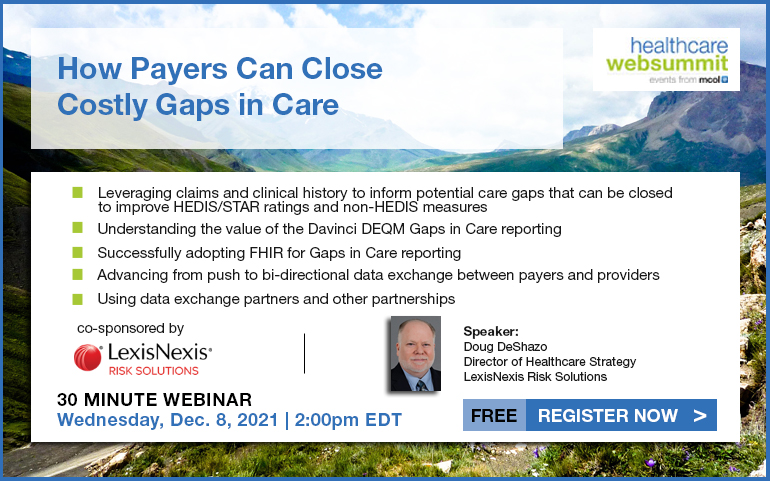Webinar: How Payers Can Close Costly Gaps in Care
Please join us on Wednesday, December 8, 2021, at 2 PM Eastern for a 30-minute webinar as Doug DeShazo, Director of Healthcare Strategy, LexisNexis Risk Solutions discusses leveraging claims and clinical history to inform potential care gaps that can be closed to improve HEDIS/STAR ratings and non-HEDIS measures, in the HealthcareWebSummit event co-sponsored by LexisNexis Risk Solutions: How Payers Can Close Costly Gaps in Care.
![]()
Overview
Webinar: Wednesday, December 8, 2021, at 2:00 PM – 2:30 PM Eastern
- Leveraging claims and clinical history to inform potential care gaps that can be closed to improve HEDIS/STAR ratings and non-HEDIS measures
- Understanding the value of the Davinci DEQM (Data Exchange for Quality Measures) Gaps in Care reporting
- Successfully adopting FHIR for Gaps in Care reporting
- Advancing from push to bi-directional data exchange between payers and providers, enabling information exchange about specific care gap closures
- Using data exchange partners and other partnerships to help with Patient Access API (USCDI), CARIN (CPCDS claims) and gaps calculations
Speakers: Doug DeShazo, Director of Healthcare Strategy, LexisNexis Risk Solutions
In healthcare, "gaps in care" refers to the gaps that exist between best practices and actual patient care. Closing these gaps is important to deliver value-based care and quality of care. Additionally, care gaps, when not properly managed, can be both harmful and costly. Reporting of open care gaps and closing care gaps is a core component of value-based care between payers and providers.
Health Level Seven International (HL7), the not-for-profit, ANSI-accredited standards developing organization, introduced Fast Healthcare Interoperability Resources (FHIR), to address interoperability challenges as "a new standard for exchanging healthcare information electronically. The HL7 FHIR standard is well-suited to form the basis of real-time API data exchange between applications, devices, and systems. The HL7 Da Vinci Project was born out of the need to accelerate FHIR adoption" to support and integrate value-based care and payment model data exchange.
Join this webinar to learn about leveraging claims and clinical history to inform potential care gaps that can be closed to improve HEDIS/STAR ratings and non-HEDIS measures.
Registration Details
- Registration is complimentary for qualified applicants
- Click here to register
Learning Objectives
Attendees will learn:
- How to improve HEDIS/STAR ratings and non-HEDIS measures by leveraging claims and clinical history to inform potential care gaps that can be closed
- A review of Davinci DEQM (Data Exchange for Quality Measures) Gaps in Care reporting
- How to successfully adopt FHIR for Gaps in Care reporting
- How to advance from push to bi-directional data exchange
- What’s involved in using data exchange partners and other partnerships to help with Patient Access API (USCDI), CARIN (CPCDS claims) and gaps calculations
Who Should Attend
Interested attendees would include:
- C-Suite Executives
- Care Management Executives and Staff
- Information Technology Executives
- Directors of Interoperability and Staff
- Data Governance Executives and Staff
- Analytics Executives and Staff
- Planning and Strategy Executives and Staff
- Business Intelligence Staff
- Other Interested Parties
Attendees would represent organizations including:
- Health Plans
- Other Purchasers
- Associations, Institutes and Research Organizations
- Media
- Other Interested Organizations
Speakers
|
Doug DeShazo |
Director of Healthcare Strategy Doug DeShazo is an experienced professional with broad industry experience. He has extensive experience in integration and interoperability architecture and design for large scale healthcare system enterprise projects, EHR integrations, clinical laboratory integrations, and hospital information systems, operations, and management. He has recently focused on leading large-scale HIE implementations including standards and architecture. |


